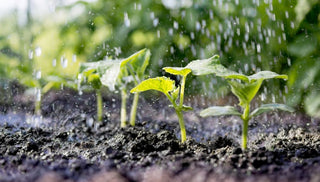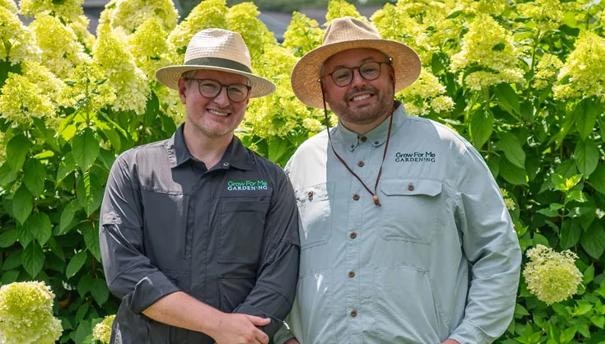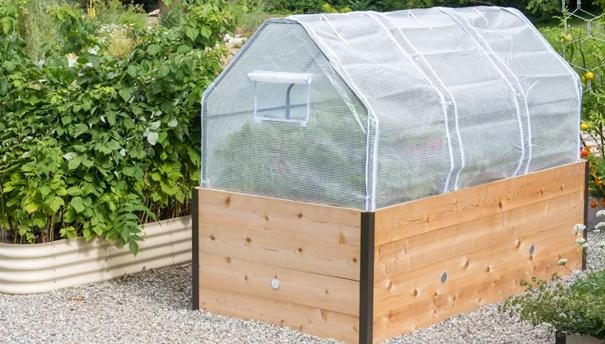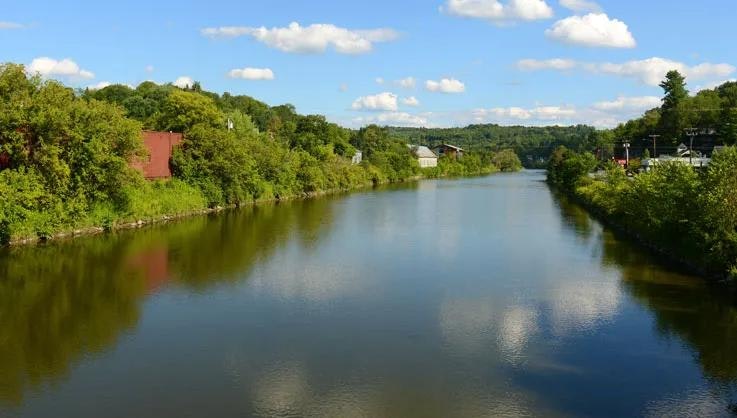Plants are pretty simple — with high quality soil and regular water, they'll churn out lush foliage, beautiful flowers, and loads of delicious fruits. A lack of water, however, can quickly lead to sad plants and poor garden yields. As gardeners, we are always crossing our fingers for regular rain, but when we can't rely on Mother Nature, it's time to turn on the faucet.
Let's dive in to our most frequently asked watering questions:
In this Article
Watering the Garden
How often do I need to water my garden?
Watering needs will vary depending on the type of plant, age of plants (seedlings need water much more frequently than mature perennials), type of soil (sandy soil dries out much faster than heavier soils) and of course, the climate and daily weather. A good way to tell if your garden is lacking moisture is to simply push away any mulch from the soil surface, and then poke your finger down into the soil. Even if the top inch of soil is dry, the lower soil should be moist.
How can I tell if my plants aren't getting enough water?
Immediate heat stress generally looks like limp leaves and wilting plants. Under a long term drought, you may see undersized or shriveled fruit, tough or bitter -tasting harvests, or plants that are just plain dead.
How often should I water a newly planted tree?
Proper moisture is critical to the survival of your young tree or shrub. The roots should never dry out completely, nor should they be waterlogged. The best way to check soil moisture? Use your finger. Dig down 2" to 4" just outside the root mass of the plant and water if the soil feels dry. Newly planted shrubs and trees should be checked and watered every other day for the first two weeks. After the first two weeks, limit watering to once a week if less than 1" of rain falls during the week. Thorough soakings that moisten the soil to the entire depth of the root mass are better than frequent light waterings.
How often should I water my seedlings?
When the seeds are just beginning to germinate, before they have true leaves, you'll want to mist the surface of the potting medium regularly, and once they are more developed, you can bottom water them in a self watering seed tray.
What is "bottom watering"?
Instead of pouring water over the top of your plants, the contatiners are placed in a shallow tray or dish of water. Water is drawn up into the soil from the tray via capillary action. Bottom watering is especially beneficial for seedlings — it promotes healthy root growth, avoids flooding tiny seeds, and most importantly, prevents fungus and disease from taking over.
What is a self-watering container?
Self-watering containers have an inner pot that holds the plant and soil, and an outer pot or bottom reservoir that holds extra water. A wick joins the two and pulls water up into the root ball as it's needed. Most reservoirs are large enough to supply water for several days or more depending on the weather. Liquid fertilizer can be added to the reservoir to ensure an adequate supply of nutrients. These containers can generally be used both indoors and out.
When should I use a sprinkler system versus drip irrigation?
Sprinkler systems are great for broadcasting water evenly and quickly over a large area (i.e. a newly seeded meadow or perennial bed), while drip irrigation provides a more targeted approach. Drip irrigation (or, soaker hoses) are excellent at directing water right into the soil, reducing water loss due to evaporation.
How do I water hanging baskets?
First, pot up your plants with a self-watering potting mix — containing perlite and vermiculite, these are designed to retain moisture while staying relatively lightweight. Reach high up hanging baskets by attaching a watering wand to your hose.
How can I keep my garden watered while I'm away on vacation?
For raised beds and in-ground gardens, install a programmable timer at your water source, and connect it to a sprinkler or soaker hose system. For maximum water conservation (and minimal water loss!), set the timer to water during morning or early evening hours.
For containers and planters, consider moving your plants into a self-watering container. Fill the water reservoir before you leave, and water will slowly transfer into the soil over time.
Conserving Water
How can I conserve water in my garden?
There are plenty of tricks and techniques that will help your garden retain moisture during drier times.
- Mulch with either weed-barrier fabrics or natural mulch (woodchips, straw, etcetera) keeps water from evaporating and prevents weeds from drinking the water that your garden plants could use.
- Add compost to the soil, which improves its ability to supply your plants with just the right amount of water. Sandy soil is very porous — water will run right through it — amending with compost will make the texture more spongy and water-retentive.
- Consider setting up soaker hoses and drip irrigation systems in your garden. These have tiny holes which leak water slowly right at soil level, and are a very efficient way to water.
- Water in the morning or early evening, when there is a better chance of the water going into the soil as oppoosed to being evaporated by the hot midday sun.
- For landscaped areas, choose drought-resistant trees, shrubs, and perennials that are naturally adapted to dry conditions.
Can I use a rain barrel to water plants?
Yes! Rainwater is unchlorinated, untreated, and best of all, FREE! A rain barrel is a great way to collect and store water to be used on your garden and home landscape. Residential rain barrels come in all shapes, sizes and colors and are designed to intercept and store runoff from rooftops. These barrels may also have spigots that you can use to fill a watering can with or attach a 6-foot leader hose.
One thing to keep in mind is that if your water is from a roof surface, it can pick up bacteria and possibly chemicals from roofing materials — consider using this rainwater on non-edible plants.
What size rain barrel do I need?
If you want to start small and keep it simple, consider a wood or plastic rain barrel, which will typically hold from 40 to 80 gallons of water. If you have the space, several barrels can be set up in tandem. To properly size a rain barrel to your roof, plug your roof dimensions in to the Rainfall Harvest Calculator. Scope out the site where you want to place the barrel, and look at the gutters to see if a downspout diverter might be needed. If you don't have suitable gutters, you can direct water into a vessel using a rain chain. You'll want a barrel that you can access easily.
Can I attached a hose to my rain barrel?
For a rain barrel, you need nothing more than a standard spigot or short length of hose installed near the bottom of the barrel, with an on/off valve. Then you let gravity do the work. Typically, there is not enough water pressure for even distribution on a longer length hose. There are battery powered water pumps to help with that.
Someone told me that watering when it's really sunny will burn plant foliage. Is that true?
Nope! In reality, the water will evaporate way before it acts as a tiny magnifying glass. Foliage damage is much more likely due to insects, disease, over-fertilization, or frost. Watering during really sunny, hot times of the day IS inefficient however — water in the morning or early evening to maximize the amount of water actually getting to plant roots.
Hoses and Irrigation
How long do I keep my soaker hose on in the garden?
On average you can start with 30 minutes, 2-3 times per week and adjust as needed. You want to be sure that the soaker hose is reaching root systems. A low and slow flow will provide the roots of your plants with about an inch of water per session. After each session, using a 6” spade, carefully dig down in your soil to check how deep the water went.
My soaker hose is clogged. What should I do?
Soaker hoses can get clogged with soil and mineral deposits that are in your water. If you have mineral deposits you will see visible staining accumulate on your hoses. You can clean this up by soaking your hose in a vinegar solution. You can also flush your hose with running water a few times a season. Remove the end caps and let any debris work itself out of the lines.
Why has water stopped flowing all the way to the end of the soaker hose?
There could be several reasons this is happening. First, check for debris or mineral deposits that may be clogging the line (see above). Next, check the water pressure. Soaker hoses will not distribute an even flow if the pressure is either too high or too low. High pressure will cause splits or leaks at the front of the hose. Low pressure will underwater areas near the end of the hose. Using a water pressure regulator will help control the rate of flow at 10 PSI.
Do I need to remove my soaker hoses for the winter?
Drain your soaker hose before freezing weather to prevent the hose from splitting. You can leave in place for the winter or store in a shed/garage. Adding a layer of mulch like straw over it will help protect it from the harsh elements.
What kind of hose won't kink?
Storing your hoses properly will help prevent kinking and prolong the life of the hose. Hoses should be hung properly on a hose mount or hose reel. It is also best to keep the hose out of full sun when not in use-this will help keep the hose material from degrading due to high heat and harsh sun exposure. The longer the hose, the more common it is to kink. To help prevent kinking, straighten out the hose before you start watering. This will help prevent kinking in hoses 50' or more.
How can I prolong the life of my garden hose?
Coiling your hose correctly and storing out of UV rays either in a hose pot or on a reel will help prolong the life of the hose. Drain hoses thoroughly at the end of the season to ensure freezing/thawing cycles don't crack the hose.
How do I know which Snip-n-Drip system to use?
Draw out a overhead view of your garden plot and mark where you want the water to flow, where you want connector hoses, and what angles you need to account for. Use this to decide if you need a splitter at your water source, as well. Check out a simple Snip-n-Drip diagram here.
Houseplant Watering
How much water do my houseplants need?
Most plants (but not all!) like to get thoroughly watered and then allowed to dry out before the next watering. Deeper saturation is much more effective than frequent little sprinkles on the soil surface. Research the type of plants you have, as different varieties require different amounts of water. Do you have a cactus? A moisture-loving staghorn fern? More houseplants die from overwatering than from anything else. The best advice is to resist the temptation to water on a regular schedule. Your plants will require frequent watering if the weather has been sunny and warm, and they may not need a drop if the weather has been cool and cloudy. Make a habit of checking the soil of at least a few indicator plants, and water only if it feels dry to a depth of ½ to 1 inch.
How can I keep my houseplants watered while I'm away on vacation?
If you'll only be gone for a few days, simply move your houseplants out of direct sunlight — close the shades — or shift them toward the center of the room. This will slow growth and reduce moisture loss. Water thoroughly right before you depart, making sure that moisture penetrates to the center of the root ball.
If you'll be gone for longer, consider moving your plants into self-watering containers. Top off the water reservoir before you depart, and the wicking action of the planter will continue to move moisture into the soil.
What should I use to water my houseplants?
To avoid spills and navigate around leaves, consider using a lightweight watering can with a narrow spout. For heavily plant-filled homes, consider using a portable tank with an attached hose.




